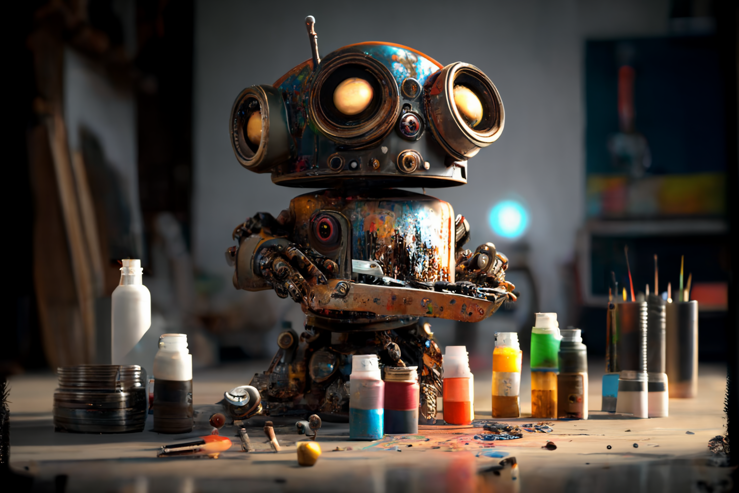Is AI art actually art, or a counterfeit craft?
4 min read
The boom in AI-powered technologies is fuelling conversation across the internet, ranging from the curious who are inspired and excited by the possibilities, to those looking for a safehouse to protect them from our very own Skynet of today. One of the more hotly debated developments is text-to-image AI art, and whether a machine can be credited as a true artist, or whether it will only succeed in referencing published works and evolving existing artistic styles.
What does AI generated art mean for digital artists? Is AI art… a counterfeit craft?
The three big players in the text-to-image space (Dall-E 2, Midjourney and Stable Diffusion) are at the forefront of something truly amazing, evolving at pace. Each handles text prompts slightly differently, but in essence, you type an idea and the AI produces an image based on the prompt.
Sounds simple enough. So, I signed up, typed in my first prompt, and excitedly awaited the image in my mind’s eye to materialise.
I was left decidedly underwhelmed by the image that appeared, with quality akin to a messy Photoshop montage and little resemblance to the ‘detective-Pikachu-dining-in-a-steampunk-inspired-utopia-gouache-painting’ that I asked for.
Mastering prompts isn’t as straightforward as I had assumed. Text-to-image imagery will only ever be as good as your imagination and understanding of how to get the best out of the platform. Text-to-image prompts need time investment – trial-and-error, crafting, and a strong imagination – to create truly amazing results. Creating the best prompts has become an art form itself, and a micro-economy has emerged offering prompts for sale.
The adopters v the resistance
For many, text-to-image is a fun tool. Some media organisations have used them to create nice graphics, and for artist Kris Kashtanova, Midjourney was the ideal media choice for creating the art in her 18-page graphic comic, Zarya of the Dawn.
On the other side of the spectrum, we have The Resistance: the digital artists who fear the text-to-image-T1000s. Is AI going to put them out of a job, ripping off their art to pass it off as its own? Or is it just looking for Sarah Connor?
Rather than a straight shootout, a more insightful discussion for digital artists would focus on the question, ‘If you haven’t put the hours in and honed your craft for years, should your text-to-image art receive the same respect as existing art forms, or is it just the next evolution of image automation?’.
All technological advances are part of a larger magic wand we use to make barriers disappear. From home camcorders unlocking the potential of future directors to advances in CGI opening animation opportunities beyond those with access to expensive cell-based animation, technology has always served to brush aside the barriers to the clubs of elitist, commercialised art forms.
Does technology reduce the validity of the art it helps produce?
Digital artist Rob Sheridan recently told an interesting story. An old lady who lived in a small village knew most of her neighbours as friends. Come Autumn, she would search for the perfect fallen leaf from a 600-year-old oak tree at the centre of the picture-perfect village green. She would dry and press the leaf, then later in the year she would put it in a glass frame, and give it as a gift to one of her neighbours.
The old lady didn’t make the leaves or the frames, but the moment she pulled all the parts together to make her gift, it became her art. They might never hang in a gallery, but to the villagers, they’re works of art.
The story illustrates the curation that is a part of so much art. A portrait photographer doesn’t create the person, or content, of their work. They use a blend of technology, training and talent to curate the image.
AI text-to-image is an enabler - a superpower that can accelerate the creation of digital art. Under the lens of a curator, it’s a tool that should widen the pool of digital artists with the removal of traditional craft-based barriers.
More opportunities after all?
‘But it will take our jobs!’ cry the pitchfork-waving Resistance. Yes, inevitably, there will be some casualties. But the casualties will, most likely, be from communities who pull up the drawbridge and don’t embrace the new technologies influencing a changing commercial landscape. The curious, early adopters will be in a strong position to lead the charge as digital artists move their expertise into new roles that are created as others become more crowded (and in reduced demand).
Take games studios. Looking back at the 90s, one of the big nostalgia triggers for digital artists is video games like Grand Theft Auto. Released in 1997, it was ground-breaking. However, the concept artists on the development team were a very small group of just four people.
With developments in CGI and better hardware becoming available, games studios want to make bigger and better games. This has created a need to develop more characters, maps, menus, and objects in the game world, requiring a much larger team of digital artists. Fast forward to September 2013, and Grand Theft Auto 5 required a huge development team, employing 163 people who had ‘artist’ in their job title. Advances in technology can create new opportunities for digital artists.
AI text-to-image is the next step in image automation. The genie is out of the bottle, with little sign of it returning. Should digital artists live in fear? No, not as much as commercial image libraries should. Previous waves of technological advances illustrate perfectly why digital artists should become early adopters of AI-powered text-to-image platforms and employ this amazing tool as part of their brush set to produce art that is considered curative, not counterfeit.
As published in The Drum